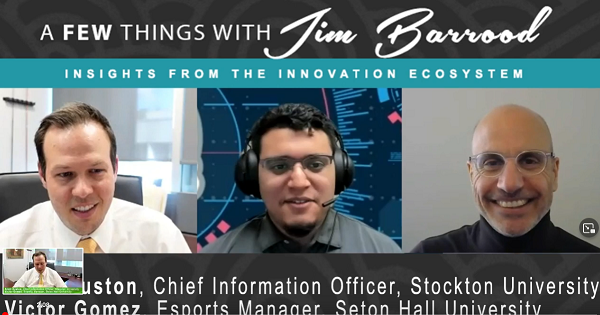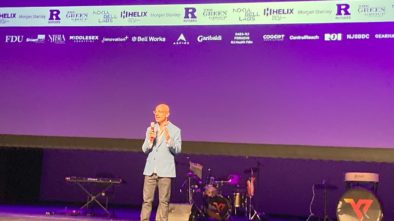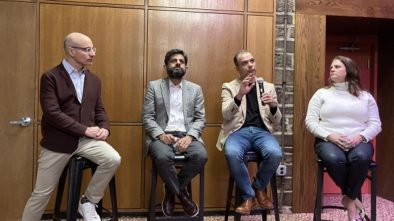ESports Growing on New Jersey College Campuses, Experts Tell Barrood
ESports, competitive online gaming in which players are organized into teams and play in tournaments to win recognition and monetary rewards, is a big thing on college campuses in New Jersey. College administrators say that having an esports team or several teams can be a draw, attracting students to their institutions.
In November, James Barrood, founder and CEO of Innovation+, spoke with two accomplished heads of esports programs in New Jersey — Scott Huston, CIO at Stockton University, and Victor Gomez, esports manager at Seton Hall University — about the growth of college esports in the state. The video of their chat can be found here.
Gomez founded the esports program at Seton Hall while still a student. Then he left, did some consulting, and came back to run it. Seton Hall’s program is new, and the players compete at the varsity level.
At Stockton, esports comes under the aegis of the information technology department, Huston said. Stockton started off with a program that had only a few students, but the college’s last esports get-together attracted over 500 students. Huston was also recently appointed chair of the new esports innovation center, which will be located in Atlantic City.
Since esports can be played remotely, its growth continued during the pandemic. “One of the only silver linings of the pandemic was that a lot of students were home and looking for an activity to do from their home, so those who weren’t gamers became gamers,” Huston noted.
“One of the only silver linings of the pandemic was that a lot of students were home and looking for an activity to do from their home, so those who weren’t gamers became gamers.”Scott Huston, Stockton University
Gomez believes that, as with any kind of competition, esports is better in person because “you can have the fans right there cheering you on.” However, that can’t always happen. “We played Stockton remotely,” but played DePaul University in person at an event in New York City, he said.
The labs at the two schools are state of the art. At Seton Hall, the lab contains 16 top-of-the-line machines from Lenovo, six monitors with under 33-millisecond response times, dedicated wiring for each of the 16 machines, mechanical keyboards, mice, mouse pads and headsets. The lab is constructed so as to remove anything that causes interference or time lags.
Gomez added that while he was consulting with Seton Hall about creating the lab, he asked for a dedicated network switch. “The main reason for that is that we have a large population on campus,” including visitors, students, faculty and staff, which takes up a lot of bandwidth. With a dedicated switch, “we can focus on the esports students receiving a top-of-the-line signal.”
When Stockton started out, the students who were going to be involved in esports built the 18 machines they would be using, Huston said. “Shockingly, to this day, we’ve had fewer problems with those machines than any of the ones that came from a manufacturer.” That first lab became the “blue room.”
As the program began to expand, there was another space that could be repurposed, so they purchased 24 machines for that space to handle some of the growth. They painted the room gold, and that became the “gold room.” There is a competition between the two rooms.
More Than Just Competitive Gaming
The program has taken over an entire building on campus and is always looking to expand, Huston said. “Every semester, we have more and more students signing up.” They are not just competing, but are also getting involved in the many other activities, such as broadcasting, streaming and behind-the-scenes networking. “It’s not just about playing the video games. It’s about the entire ecosphere,” Huston said.
Besides participating in sanctioned competitive events, Stockton puts on events for its own esports gamers. Huston said that at many of these events, there is a 50-50 ratio of male/female participants. There are about 550 students involved in esports at Stockton, with about 75 of them involved in tournaments. At Seton Hall, where esports competitions are at the varsity level, there are 18 students involved in competitive play, with about 550 participating in the more casual gaming on the Discord site and about 156 participating on the more competitive Stockton eSports Discord site. Both schools have a student population of about 10,000.
ESports itself is a bit unregulated, so that a school like Stockton can compete with a school like Ohio State. This has been good for the sport, Huston said, because it has allowed it to grow organically. “There are many different leagues forming, so you can find the one the fits your purpose the best.”
Many people wonder about the effect of esports on mental health, but the two university execs agreed that esports has brought many introverts out of their shells and helped them make friends through the connections they’ve made playing the games.
The Business of Esports
Parents often object to esports because they believe that it offers no academic benefits. However, the two university execs are adamant that this isn’t true. Students are enhancing their learning abilities and mental acuity through problem solving and teamwork. They are also learning technology and how to stream and promote events. Universities are also creating esports minors and majors, so that students can learn the business of esports. This is a big business, with professional players making as much as NBA players, the execs noted.
Others wonder about the physical effects of competing at a computer console for hours at a time, especially if the students don’t get enough exercise. Gomez pointed out that going to an in-person tournament was eye-opening for the school administrators and parents who attended. For example, during one tournament the players stayed at a hotel. The small contingent of administrators who were there thought they’d have to wake up the players because they had been gaming late into the night. “My players were all in the gym at 6 a.m.,” Gomez reported. “They said, ‘We need to make sure to get in our workout before we can play.’”
Elaborating, he said that gamers primarily do cardio to be able to tolerate sitting for six-hour tournaments. They need to stretch their wrists to avoid the common problems that prevent some gamers from continuing to play, maladies like carpal tunnel syndrome. During the games, players are told to get up and walk during breaks, hydrate and pay attention to their posture.
“I think it’s a world of a difference from the more common misnomer that gamers are just locked up in a basement, for example, eating Doritos and drinking Mountain Dew, right? The definition of gamer has really evolved, especially in this day and age,” said Gomez.
Gaming is beautiful because of its accessibility.Victor Gomez, Seton Hall University
Gaming isn’t restricted to the typical “bro culture” stereotype, he added. Gamers come from all walks of life, and some of the best streamers on Twitch are differently abled, Gomez stated.
“Gaming is so beautiful because of its accessibility. We have people who can play without needing to use their legs or hands, and one of the most successful college streamers is playing with a tube that reads how he blows into it, to then moves his character. Microsoft has made a lot of strides with their pro controller, to make it possible for differently abled people to be able to play the games that everyone else can. It’s great that students from a wide array of backgrounds, talents, majors can get into esports.”
In response to a question about the acceptance of women in esports, Huston stated that as esports becomes less about playing the games and more about the entire ecosystem surrounding it, more and more women are participating in the industry. At Stockton, many of the student team leaders are women, he said. The university was also approached by an all-female team to see if the female players wanted to be involved in it, but the Stockton students declined, stating they didn’t need to be in a female league. “They were competing with the male players just as well as anyone else.”
Gomez agreed that things are getting better, but he acknowledged that “in the West, I think we’re doing a lot of catch-up in the inclusion of women and female-identifying persons.” He noted that Eastern countries have many more competitive women players, and in some games 60 percent of the players are female, “something we could only dream of in North America.”




